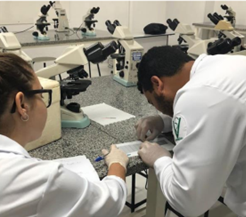Comparative analysis between methodologies for determining hematocrit of dogs and horses
DOI:
https://doi.org/10.31533/pubvet.v18n11e1676Keywords:
automation, hemathology, pathology, veterinaryAbstract
This study aimed to analyze and statistically compare the hematocrit values obtained from the processing of whole blood samples in EDTA from 20 dogs and 17 horses using the microhematocrit methodology and the GENVET 3-part VH20 Hematological Analyzer, in order to verify the accuracy of automated analysis. The automated technique demonstrated statistically similar results, with an average bias of 1.47% between the methodologies in the canine species and 1.48% in the equine species. It was concluded that automated analysis produces results with minimal variability, little affecting the laboratory interpretation of the hematocrit index in canine and equine patients.
References
Amaral, J. B., & Trevisan, G. (2018). Relação homem-animal durante procedimento clínico cirúrgico e pós-operatório em bezerro Holandês Preto e Branco acometido por atresia anal: Relato de caso. PUBVET, 12(3), 1–9. https://doi.org/10.22256/pubvet.v12n3a59.1-9.
Athanasiou, L. V., Polizopoulou, Z., Kalafati, M. R., Ntararas, G., & Kontos, V. (2016). Effects of pre-analytical handling on selected canine hematological parameters evaluated by automatic analyzer. Veterinary Research Forum, 7(4), 281–285.
Brooks, M. B., Harr, K. E., Seelig, D. M., Wardrop, K. J. & Weiss, D. J. (2022). Schalm’s Veterinary Hematology (7th ed.). John Wiley & Sons Inc, Medford, MA, USA.
Chaves, C. D. (2010). Controle de qualidade no laboratório de análises clínicas. In Jornal Brasileiro de Patologia e Medicina Laboratorial (Vol. 46, Issue 5). https://doi.org/10.31512/persp.v.47.n.177.2023.318.
DeNicola, D. B. (2011). Advances in hematology analyzers. In Topics in Companion Animal Medicine (Vol. 26, Issue 2). https://doi.org/10.1053/j.tcam.2011.02.001.
Ferreira, S. A., & Sampaio, I. B. M. (2010). Relação homem-animal e bem-estar do cão domiciliado. Archives of Veterinary Science, 15(1), 22–35.
Flatland, B., Freeman, K. P., Friedrichs, K. R., Vap, L. M., Getzy, K. M., Evans, E. W., & Harr, K. E. (2010). ASVCP quality assurance guidelines: Control of general analytical factors in veterinary laboratories. Veterinary Clinical Pathology, 39(3). https://doi.org/10.1111/j.1939-165X.2010.00251.x.
Goyena, R., & Fallis, A. G. (2016). Hematologia laboratorial: Teoria e procedimentos. Journal of Chemical Information and Modeling (Vol. 53, Issue 9).
Graham, M. D. (2003). The Coulter Principle: Foundation of an industry. JALA - Journal of the Association for Laboratory Automation, 8(6). https://doi.org/10.1016/s1535-5535-03-00023-6
Grotto, H. Z. W. (2009). O hemograma: Importância para a interpretação da biópsia. Revista Brasileira de Hematologia e Hemoterapia, 31(3). https://doi.org/10.1590/S1516-84842009005000045.
Koplitz, S. L., Scott, M. A., & Cohn, L. A. (2001). Effects of platelet clumping on platelet concentrations measured by use of impedance or buffy coat analysis in dogs. Journal of the American Veterinary Medical Association, 219(11). https://doi.org/10.2460/javma.2001.219.1552.
Lee, N. Y. (2019). Reduction of pre-analytical errors in the clinical laboratory at the University Hospital of Korea through quality improvement activities. Clinical Biochemistry, 70. https://doi.org/10.1016/j.clinbiochem.2019.05.016.
Leonart, M. S. S. (2010). Controle de qualidade na preservação de eritrócitos para transfusão. Revista Brasileira de Hematologia e Hemoterapia, 32(3). https://doi.org/10.1590/s1516-84842010000300003.
McCulloch, W. F. (1985). The veterinarian’s education about the human-animal bond and animal-facilitated therapy. The Veterinary Clinics of North America. Small Animal Practice, 15(2), 423–429. https://doi.org/10.1016/S0195-5616(85)50314-9.
Naoum, P. C. (2001). Avanços tecnológicos em hematologia laboratorial. In Revista Brasileira de Hematologia e Hemoterapia (Vol. 23, Issue 2). https://doi.org/10.1590/s1516-84842001000200010.
Paes, P. R. O., Leme, F. O. P., & Carneiro, R. A. (2009). Hematologia dos animais domésticos. FEPMVZ, Caderno Didático.
Rebar, A. H., MacWilliams, P. S., Feldman, B. F., Metzger, F. L., Pollock, R. V. H., & Roche, R. (2001). Laboratory methods in hematology. In A. H. Rebar, P. S. MacWilliams, B. F. Feldman, F. L. Metzer, R. V. H. Pollock, & j Roche (Eds.), A guide to hematology in dogs and cats.
Reis, B. M. E. S., & Fonseca, L. S. (2024). A padronização das técnicas hematológicas no laboratório veterinário no aprendizado discente. Revista Eletrônica Científica Ensino Interdisciplinar, 10(32), 105–117. https://doi.org/10.21920/recci,v10i32.5849.
Silva, J. P. B., Navegantes, K. C., Pereira, G. C. B., Chiba, J. M. C., Dias, R. G. C., & Percário, S. (2014). Avaliação do impacto de laboratórios de análises clínicas de hospitais de urgência e emergência do município de Belém-PA na saúde. Revista de Ciências Farmacêuticas Básica e Aplicada, 35(1).
Tatibana, L. S., & Costa-Val, A. P. (2009). Relação homem-animal de companhia e o papel do médico veterinário. Revista Veterinária e Zootecnia Em Minas, 1, 12–19.
Thrall, M. A., Weiser, G., Allison, R. W., & Campbell, T. W. (2022). Veterinary hematology, clinical chemistry, and cytology. John Wiley & Sons.
Weiss, D. J., & Wardrop, J. K. (2010). Schalm’s Veterinary Hematology.
Young, M. S. (1985). The evolution of domestic pets and companion animals. The Veterinary Clinics of North America. Small Animal Practice, 15(2), 297–309. https://doi.org/10.1016/S0195-5616(85)50302-2.

Downloads
Published
Issue
Section
License
Copyright (c) 2024 Thiago Oliveira de Almeida, Anna Laura Rodrigues Cabral, Camila Ribeiro Cibien Machado, Tiago Martins do Prado

This work is licensed under a Creative Commons Attribution 4.0 International License.
Você tem o direito de:
Compartilhar — copiar e redistribuir o material em qualquer suporte ou formato
Adaptar — remixar, transformar, e criar a partir do material para qualquer fim, mesmo que comercial.
O licenciante não pode revogar estes direitos desde que você respeite os termos da licença. De acordo com os termos seguintes:
Atribuição
— Você deve dar o crédito apropriado, prover um link para a licença e indicar se mudanças foram feitas. Você deve fazê-lo em qualquer circunstância razoável, mas de nenhuma maneira que sugira que o licenciante apoia você ou o seu uso. Sem restrições adicionais
— Você não pode aplicar termos jurídicos ou medidas de caráter tecnológico que restrinjam legalmente outros de fazerem algo que a licença permita.




